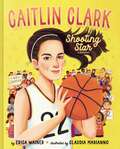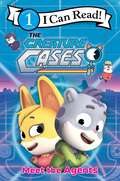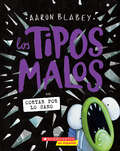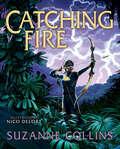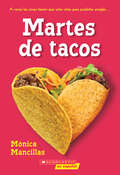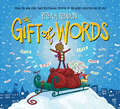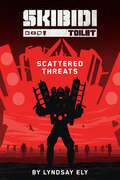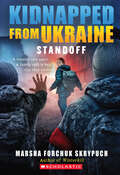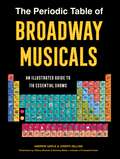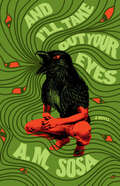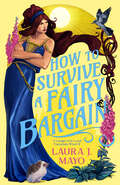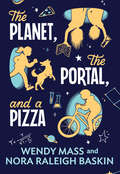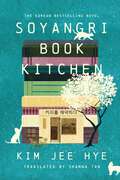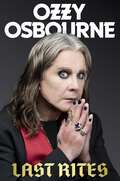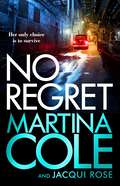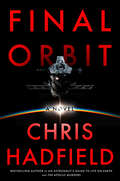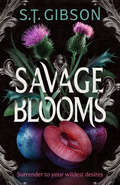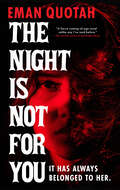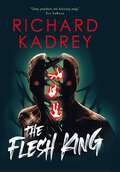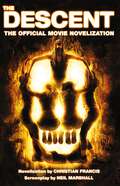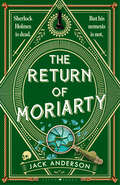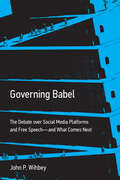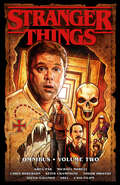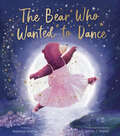- Table View
- List View
A Witch in Notting Hill: A Novel
by Alexandra PaigePerfect for fans of The Very Secret Society of Irregular Witches, this cozy and whimsical romance follows an accident-prone witch and a hot grumpy occult bookstore owner who doesn’t believe in magic as they travel across London to undo a spell gone awry. When rising Hollywood actress and secret witch Willow James accidentally turns her manager into a cat while trying to escape her contract, she’s sure she’s hit her magical low point. Determined to fix her mistake, she journeys to London in search of a rare spell hidden within the famed occult bookstore, Coven & Codex. The last thing she expects? The shop’s brooding, handsome owner, Oliver Hadley, who’d rather avoid magic altogether.Together—with a ragtag group of friends (both human and feline)—Willow and Oliver must scour every corner of the city, from museums to festivals to bustling street markets, to find the missing pieces of the spell. Along the way, Willow’s unpredictable magic and Oliver’s skeptical heart will face the one thing they can't escape… love.Filled with enchanting adventures, sparkling romance, and a dash of mischief, A Witch in Notting Hill is a sweet and spirited tale of discovering magic where you least expect it.
Caitlin Clark: Shooting Star, A Biography
by Erica WainerA slam-dunk picture book biography featuring the WNBA Rookie of the Year and one of the biggest names in basketball—Caitlin Clark!Caitlin's love for the game is evident every time she steps foot on a court, whether for a pickup game with her brothers as a kid, during college with the Iowa Hawkeyes, or in WNBA arenas watched by millions of TV and courtside viewers. While Caitlin now has fans all over the world, it’s in her home state of Iowa where she first develops her dedication, generosity, and passion—all the ingredients for the inspirational “Caitlin Clark effect.” Follow along as Caitlin takes the WNBA world by storm, becoming the number one overall pick for the Indiana Fever and Rookie of the Year.
The Creature Cases: Meet the Agents (I Can Read Level 1)
by Alexandra WestReady to meet the team? Join Kit Casey and Sam Snow, two top agents from the Covert League of Animal Detective Experts, as they introduce you to the world of CLADE!A hit Netflix show, The Creature Cases follows animal agents Kit Casey and Sam Snow as they solve mysteries in the animal kingdom using their top-secret spyware and sleuthing skills. This book is a Level One I Can Read, perfect for children learning to sound out words and sentences. Whether shared at home or in a classroom, the short sentences, familiar words, and simple concepts of Level One books support success for children eager to start reading on their own.
Los tipos malos en cortar por lo sano (The Bad Guys in Cut to the Chase)
by Aaron Blabey¡AHORA CONVERTIDO EN UNA PELÍCULA!¡UNA PUERTA MISTERIOSA! (Es cierto que está en el restaurante más asqueroso del mundo, pero eso no la hace menos misteriosa, ¿de acuerdo?) ¡Miren! ¡¿Qué hay más allá?! ¿Un ciempiés malvado? ¿Un universo alternativo? ¿Unas explicaciones decentes? ¡BRRRUM! ¡CLIN! ¡CLIN! ¡CLIN!NOW A MAJOR MOTION PICTURE!A MYSTERIOUS DOORWAY! (Sure, it’s in the grossest restaurant in the world, but that doesn’t make it any less mysterious. OK?) Behold! What lies beyond?! An evil centipede? An alternate universe? A few decent explanations? VRRRING! NING! NING! NING!
Catching Fire: Illustrated Edition (The Hunger Games)
by Suzanne CollinsWith stunning illustrations by Nico Delort, this keepsake edition is a definitive volume for all Hunger Games fans.Against all odds, Katniss Everdeen has won the annual Hunger Games with fellow district tribute Peeta Mellark. Katniss and Peeta should be happy. After all, they have just earned for themselves and their families a life of safety and plenty. But it was a victory won by defiance of the Capitol and their harsh rules, and now there are rumors of rebellion in the districts. Katniss and Peeta, to their horror, are the faces of that rebellion. The Capitol is angry. The Capitol wants revenge.
Taco Tuesdays: A Wish Novel (Spanish Edition)
by Monica Mancillas¡Un libro de comida de la serie DESEO! Mónica Mancillas explora los temas de la familia, la comida y la identidad en un título dulce y comercial.Dulce no quiere pasar el verano ayudando en el restaurante de su familia, pero como el negocio necesita toda la ayuda posible, no tiene otra opción. Julian no quiere estar en California, pero sus padres, blogueros gastronómicos, se han mudado para tratar de salvar su matrimonio, por lo que él tampoco tiene otra opción. Cuando ambos dos literalmente chocan, no es el comienzo de una hermosa amistad, pero cuando ambos se ven obligados a inscribirse en una clase de cocina y poco a poco se van conociendo, las cosas se calientan, ¡y no hablamos solo de tacos! Julián y Dulce tienen algo que aprender sobre la amistad, la familia, la comunidad y la comida.Nacho average foodie WISH book! Mónica Mancillas explores themes of family, food, and identity wrapped up in a sweet, commercial title.Dulce doesn’t want to spend the summer helping at her family’s restaurant, but with the business needing all the help it can get, she doesn’t have a choice. Julian doesn’t want to be in California. But his food vloger parents have relocated the family as part of an attempt to keep their marriage going, so he doesn’t have a choice, either. When the two literally crash into each other, it’s so not the beginning of a beautiful friendship. But as they’re both forced to enroll in a cooking class together and slowly get to know each other, things get heated—and not just the tacos! Julian and Dulce each have something to learn from the other about friendship, family, community, and food.
The Gift of Words (A Holiday Picture Book)
by Peter H. ReynoldsAn inspirational holiday story celebrating the power of words -- an epic follow-up to the New York Times bestselling classic The Word Collector by creative visionary Peter H. Reynolds.So many words, strung together, shimmering and dreamy. So many people, connected, together, hopeful and united. And that was the power of the gift of words. A gift for all.Jerome is looking forward to collecting words this holiday season! Words of hope, love, and joy to share with his loved ones. But as he begins his search, he discovers that inspirational words are hard to come by. In the end, Jerome finds a way to connect with his community and join together in sharing the greatest gift of all: the gift of words.From our most celebrated, bestselling creator Peter H. Reynolds, comes an uplifting holiday tale about the power of the gift of words -- an important addition to the Word Collector collection, and the perfect way to celebrate the holiday season.
Scattered Threats (Skibidi Original Story #2)
by Lyndsay ElyAn action-packed story based on the fastest-growing YouTube series of all time! Includes exclusive information not available online!The Skibidi Toilet invasion struck without warning. By the time humanity understood the alien threat, the enemies had already swarmed across Earth, wiping out entire cities. The brave Cameramen have led the resistance, but they're losing ground fast – even with fresh recruits joining the fight. Without a miracle, Earth's last defenders won't hold out much longer.Plungerman is a seasoned veteran on the battlefield who can go toe-to-toe with a standard Skibidi Toilet. But when a new strain of Skibidi Toilet parasite turns the war on its head, he finds himself unprepared for the danger ahead. With the help of TV Woman, Plungerman goes searching for the enemy base, hoping to gain intel on how to defeat this new threat. This is the second in a series of three Skibidi Toilet eBook stories, featuring exclusive info you won't find in the YouTube series!
Standoff (Kidnapped From Ukraine #2)
by Marsha Forchuk SkrypuchThis gripping, accessible novel by celebrated Ukrainian Canadian author Marsha Forchuk Skrypuch follows two sisters as they struggle to survive the Russian invasion of Ukraine in February 2022.12-year-old twin sisters Rada and Dariia Popkova couldn’t be more different. Dariia is outgoing and chatty while Rada is quieter and artsy. But what they have in common is their love for each other and their home. The family lives in the Ukrainian city of Mariupol, which is attacked by the Russians on Feb 24th, 2022. The attack separates the family -- Dariia is with her mom and Rada with her dad.Rada and her father navigate the treacherous journey from shelter to shelter as they make their way to the Azovstal plant so that her father can fight in the resistance. Meanwhile, Rada is still trying to get in contact with her sister and mother. As the war rages and each family member must contend with their own battles, their love for their country and their family keeps them going.
The Periodic Table of Broadway Musicals: An Illustrated Guide to 118 Essential Shows
by Andrew Gerle Joseph ZellnikTheater lovers will adore this unique guidebook that boasts a wealth of Broadway knowledge, including adorable icons that represent each musical. Imagine the classic periodic table of elements—but instead of Chromium and Rhodium, it's A Chorus Line and RENT! This delightful and informative gift book, based on the bestselling viral poster series is a stunning showcase of art and content sure to thrill lovers of showtunes and everything Broadway and beyond. Includes a full-size pull-out poster.
And I'll Take Out Your Eyes: A Novel
by A. M. Sosa"An insultingly good debut" following a queer Chicano&’s cannon-shot into adulthood amidst familial turmoil and the suffocating violence of Stockton, California in the early 2000s (Ruth Madievsky).Cría cuervos y te sacaran los ojos: Raise crows and they&’ll take out your eyes. Since the age of seven, Christian has been under the thumb of a curse. He reads its dark signs everywhere: in his bedridden mother&’s wilting plants; in his brother&’s estrangement; in his father&’s eager fists and glassy stare. He reads it in his nightmares, in Stockton&’s soundtrack of sirens and gunshot. Above all, he reads the curse in the mirror, watching himself &“turn&” into the crow his father always predicted he&’d become. Maddened by the city&’s heatwaves and his own unthinkable desires, often high and drunk, Christian rips through his neighborhood, desperate to escape not only the city but the monster of his pain. But even when he leaves, the curse follows. Can Christian ever be absolved? Or is he condemned to be consumed by the same violence as his father? And I&’ll Take Out Your Eyes is a defiant, shattering portrait of self-discovery in the face of violence, mental illness, and other dark inheritances. In a lyric, circuit-bending onslaught of ragers and laments, A. M. Sosa delivers a redemptive story—and an unforgettable debut.
How to Survive a Fairy Bargain: A Laugh-Out-Loud Fairytale What-If (Fairies and Familiars #2)
by Laura J. MayoTheodosia&’s already survived being the evil stepsister in one fairy tale, but surviving fae bargains, fairy rings, and being turned into a hedgehog will be a whole new challenge in this hilarious sequel to Laura Mayo&’s How to Summon a Fairy Godmother. Theodosia Balfour is in a panic—she has no clue how to handle her new life as a fairy&’s familiar. She just can&’t seem to find her place in Cecily&’s land of decadence, doublespeak, and whimsy. Moreover, Theo can&’t stop thinking about Kasra, Cecily&’s last familiar who is now living a cozy human life without any memories of his time in a fairy&’s service. All she wants is to tell Kaz how she feels about him, but that&’s impossible now. Then suddenly, the regent of the fairy kingdom reveals a secret that shocks Theo to her core and thrusts her into the role of detective to solve a thousand-year-old royal assassination attempt. With time running out to catch the would-be assassin, Theo can rely on only her own wits and unique charm to discover what&’s really going on.
The Planet, the Portal, and a Pizza
by Wendy Mass Nora Raleigh BaskinMystery and adventure collide in this humorous and heartfelt multiverse adventure from beloved, award-winning authors Wendy Mass and Nora Raleigh Baskin. Twelve-year-old Piper&’s life has always been unusual: her parents are clockmakers whose inventions are anything but ordinary, and she&’s the only kid she knows with a robotic talking dog. But her life takes a turn for the truly bizarre when she discovers her parents are in jeopardy and the key to saving them is a book full of strange equations. When Raisa and Lev travel through the portal to Piper&’s world, Raisa can finally prove that her mother&’s multiverse project worked. Now, she just needs the book containing her mother&’s equations to get back to her world…if only she can find it! As Raisa and Piper adventure to the bounds of the multiverse, they&’ll need to discover their place in the world if they ever want to find their way back home.
Soyangri Book Kitchen: A Novel
by Kim Jee HyeA heartwarming novel from a South Korean author about the healing power of books, perfect for readers of Before the Coffee Gets Cold. With good books, good food and companionship, the Book Kitchen fills people's tired souls. Yoojin, who grew up in Seoul, opened the Book Kitchen by chance in Soyangri, a village two hours from Seoul by car. The Book Kitchen functions as a bookshop and cafe. The second function of the Book Kitchen is a Book Stay, where one can stay overnight in one of the building&’s four complexes. Over the course of one year, multiple characters each find comfort and hope at Yoojin&’s Book Kitchen. From a music idol facing an identity crisis, to a promising lawyer beset by an unsettling medical diagnosis, to a young, failed music director who has had to rein in his dreams, they happen upon Soyangri at pivotal moments in their lives.
Last Rites
by Ozzy Osbourne"People say to me, if you could do it all again, knowing what you know now, would you change anything? I'm like, f*** no. If I'd been clean and sober, I wouldn't be Ozzy. If I'd done normal, sensible things, I wouldn't be Ozzy."Husband. Father. Grandfather. Icon. 1948 - 2025 In 2018, at the age of sixty-nine, Ozzy Osbourne was on a triumphant farewell tour, playing to sold-out arenas and rave reviews all around the world. Then: disaster. In a matter of just a few weeks, he went from being hospitalized with a finger infection to having to abandon his tour – and all public life – as he faced near-total paralysis from the neck down. LAST RITES is the shocking, bitterly hilarious, never-before-told story of Ozzy's descent into hell. Along the way, he reflects on his extraordinary life and career, including his marriage to wife Sharon, as well as his reflections on what it took for him to get back onstage for the triumphant Back to the Beginning concert, streamed around the world, where Ozzy reunited with his Black Sabbath bandmates for the final time. Unflinching, brutally honest, but surprisingly life-affirming, Last Rites demonstrates once again why Ozzy has transcended his status as 'The Godfather of Metal' and 'The Prince of Darkness' to become a modern-day folk hero and national treasure.
No Regret: the brand new novel from the legendary author
by Martina ColePre-order the pulse-pounding new novel from queen of crime Martina Cole.'The stuff of legend' Mirror'The queen of crime' Woman & Home'One of the best fiction authors around . . . spectacular' Closer____________________Soho 1962. When Rory Sheehan decides he wants Maggie Riley as his own, her fate is sealed. Luca Romano knows all too well that what Rory wants, Rory gets. And the violence that erupts between their rival gangs is just the start of it. Thomas Johnson owes Rory big time, and he must deny his feelings for Maggie to protect her. Faced with no alternative, Maggie throws herself on Rory's mercy, unaware of the brutality that she will face.But Maggie Riley is a survivor. And the secret she's hiding could be her best weapon . . .____________________Readers love the one and only Martina Cole:'Martina Cole is back and back with an unapologetic bang' ⭐⭐⭐⭐⭐'Well worth the wait!' ⭐⭐⭐⭐⭐'Phenomenal' ⭐⭐⭐⭐⭐Due to health reasons, Martina Cole has chosen to continue her collaboration with writer Jacqui Rose for her latest novel.
Final Orbit: A Novel
by Chris HadfieldAn edge-of-your-seat thriller about China's secret role in the space race—written by the New York Times bestselling author of The Apollo Murders and one of the most experienced astronauts alive. Houston, 1975. A new Apollo mission launches into orbit, on course to dock with a Russian Soyuz craft: three NASA astronauts and three cosmonauts, joining to celebrate a new dawn of Soviet-American cooperation. But as NASA Flight Controller Kaz Zemeckis listens in from Earth, a deadly accident onboard the orbiting spacecraft changes everything. Meanwhile, from a remote location in east Asia, the first Chinese spacecraft secretly launches. On board is China&’s first astronaut, Fang Kuo-chun, whose mission puts him on a collision course with the Apollo crew. As Kaz races against an enemy on the ground and for answers beyond the sky, the safety of the remaining crew hangs in the balance… Perfect for fans of Project Hail Mary and filled with shocking twists and real history—including the fascinating story of Professor Tsien Hsue-shen, the &“Father of Chinese Rocketry&” and founder of China&’s space program—Final Orbit accelerates to a thrilling conclusion that captures the beauty and terror of survival 270 miles above Earth, as could only be written by one of the world's most experienced astronauts."Another terrific thriller from a writer who is uniquely qualified to write it.&” —Booklist "Action-filled, believable drama that flows. Readers of sci-fi thrillers by Isaac Asimov, Andy Weir, and James Michener will enjoy the realism of Hadfield&’s latest.&” —Library Journal (starred review) &“Possibly the most realistic depiction of a battle between two spacecraft ever written.…Hadfield expertly weaves fact, fiction, and his own experiences in orbit to produce a novel that is both technical and entertaining. A master of the genre.&” —New Scientist
Savage Blooms (Unearthly Delights #1)
by S. T. GibsonS. T. Gibson, the queen of erotic fantasy romance, returns with this ravishingly dark trilogy of gothic manors, faery magic, and forbidden desires set in the foreboding Highlands of Scotland. For as long as Adam can remember, the legends passed down from his world-traveling grandfather have called him to a crumbling manor in the Highlands. His closest friend Nicola longs for the same adventure, as well as for Adam himself. She'll follow him just about anywhere - even to the remote wilds of Scotland - if it pushes the pair to surrender to their shared attraction. But when a storm strikes and strands them unexpectedly, Adam and Nicola find themselves at the mercy of the eccentric owner of the infamous house, Eileen, as well as her brooding groundskeeper, Finley. Trapped by the weather, and bound by ancient faery magic, Nicola and Adam get more than they bargained for as they become entangled in Eileen and Finley's world of mind games, deceit and forbidden desire. As ancestral sins are unearthed, Adam and Nicola will have to reckon with the spell Eileen and Finley have cast over them - and whether or not they even want to be free.
The Night Is Not for You
by Eman Quotah"[A] wonderfully chilling and entirely immersive feminist horror story." —Publishers Weekly (starred review) When her sense of safety is shattered, a young girl realizes she must become something untamable—even otherworldly—to find freedom, in this visceral coming-of-age horror debut. A man&’s body is found viciously murdered behind a neighborhood corner store, sending shockwaves through the tight-knit community. All the victim&’s family and bystanders want is to make sense of this brutal crime and move on with their lives. All seven-year-old Layla wants is a pet donkey. To her, a donkey is the epitome of freedom—the ability to think for herself, go anywhere by herself, and live an independent life. The killings continue, and rumors fly of supposed hoofprints and a woman with hair like black silk. The ambiguous messages in lipstick and sweet smell of perfume at the crime scenes causes the men to suspect the women around them. As Layla&’s world unravels, she realizes she must grow into the type of woman she&’s always dreamed of becoming. A woman with sharp instincts. A woman who cannot be tamed.The night is not for you. It has always belonged to her.
The Flesh King: The Discreet Eliminators series (The Discreet Eliminators series)
by Richard KadreyTilda, Ford and Neuland hit NYC to hunt a flesh-eating monster in this bloody, macabre and witty supernatural noir packed twists, turns, betrayals and showdowns. Perfect for fans of Cassandra Khaw, Nat Cassidy and Chuck Tingle.Ford, Neuland and Tilda return home after the events of The Pale House Devil to try and make peace with the NYC crime syndicates. Then they&’ll only be welcomed back if they take on a job for free – hunting down, and killing, The Flesh King, a gruesome killer who is stalking the city, leaving a macabre and bloody trail wherever he goes. Caught up in a twisted set of conspiracies and bloodletting, the monster hunters step up to do what they do best once more – take down the unstoppable evil.
The Descent: The Official Movie Novelization
by Christian FrancisA tense and claustrophobic nightmare, this cult-classic is widely considered one of the best horror films of the 21st century. Written and directed by Neil Marshall, the director of Dog Soldiers and Hellboy, as well as episodes of Game of Thrones, Westworld and Hannibal.Scream your last breath.After a tragic accident, six friends reunite for a caving expedition. Their adventure soon goes horribly wrong when a collapse traps them deep underground and they find themselves pursued by bloodthirsty creatures. As their friendships deteriorate, they find themselves in a desperate struggle to survive the creatures and each other.
The Return of Moriarty: Sherlock Holmes Is Dead but his Nemesis Is Not
by Jack AndersonAfter Professor Moriarty survives Reichenbach Falls and Sherlock Holmes dies, Moriarty finds himself caught up in a locked-room mystery Holmes couldn&’t solve. This time, it&’s up to Moriarty to crack the mystery, perfect for fans of Sherlock Holmes ingenious retellings like the ones by Anthony Horowitz and Laurie R. King.Upon escaping from Reichenbach Falls, his empire in ruins, criminal mastermind James Moriarty takes the identity of wealthy inventor Hugo Strahm and embarks on a dark pilgrimage to the cliffside manor of Schloss Alber in Bavaria. When medical student Clara Mendel returns to Schloss Alber, she finds her childhood home on the verge of ruin. A deadly feud over a priceless heirloom has thrown the Alber family into chaos while its walls play host to an unusual cast of characters–the obstinate Lord Alber, his strange and beleaguered children, their cantankerous butler, and of course, their mysterious new guest, "Hugo Strahm." When one of them is poisoned at dinner, it&’s the first act in a spiraling criminal conspiracy, in which any and all of them are suspects.Working with the sharp and inquisitive Clara, the former crime lord attempts to solve the mystery whilst trying to keep his true identity concealed. Yet despite taking on the role of detective, Moriarty does not share Sherlock Holmes&’s methods, nor his interest in justice. Only one thing is certain, for James Moriarty, dying at the hands of Sherlock Holmes would have been an elegant end… The question of what comes next is far more complicated. This cleverly plotted mystery is a faithful and inventive take on the Sherlock Holmes legacy, paying homage to Arthur Conan Doyle&’s signature style while adding its own devious tricks to the story that is destined to become a must-read classic for Sherlock Holmes fans.
Governing Babel: The Debate over Social Media Platforms and Free Speech--and What Comes Next
by John P. WihbeyWhy social media platforms have a responsibility to look after their platforms, how they can achieve the transparency needed, and what they should do when harms arise.The large, corporate global platforms networking the world&’s publics now host most of the world&’s information and communication. Much has been written about social media platforms, and many have argued for platform accountability, responsibility, and transparency. But relatively few works have tried to place platform dynamics and challenges in the context of history, especially with an eye toward sensibly regulating these communications technologies.In Governing Babel, John Wihbey articulates a point of view in the ongoing, high-stakes debate over social media platforms and free speech about how these companies ought to manage their tremendous power.Wihbey takes readers on a journey into the high-pressure and controversial world of social media content moderation, looking at issues through relevant cultural, legal, historical, and global lenses. The book addresses a vast challenge—how to create new rules to deal with the ills of our communications and media systems—but the central argument it develops is relatively simple. The idea is that those who create and manage systems for communications hosting user-generated content have both a responsibility to look after their platforms and have a duty to respond to problems. They must, in effect, adopt a central response principle that allows their platforms to take reasonable action when potential harms present themselves. And finally, they should be judged, and subject to sanction, according to the good faith and persistence of their efforts.
Stranger Things Omnibus Volume 2 (Stranger Things)
by Chris Roberson Greg Pak Michael Moreci Keith ChampagneThe second massive collection of comics based on Netflix&’s 80&’s-nostalgia-fueled Stranger Things. Sci-fi horror at its best, including demonic creatures from other dimensions, mad scientists, secret agents, and so much more!Includes three complete series and three additional one-shot issues.The Voyage tells the story of Captain Jacoby, whose freighter ship is chartered by a group of Russians looking to get from Alaska back to Kamchatka. But when a ship mate gets butchered at sea, the captain and his crew must root out a monster while a vicious storm rages all around them.In Kamchatka, a leading Soviet scientist is abducted to work on with the Kremlin&’s new ultimate weapon—a Demogorgon! What the doctor&’s captors didn&’t count on was the resiliency of his children, who embark on a harrowing and perilous journey to find him. Their only hope of success is a retired but deadly KGB agent.Tomb of Ybwen is set in the aftermath of Bob Newby&’s death. Will Byers, still grieving his friend, discovers a mysterious map left behind by Bob. He resolves to follow the clues despite an oncoming blizzard, and Mike, Dustin and Lucas rush to stop him. The ensuing treasure hunt leads somewhere they never could have expected!Also collected here are all three Stranger Things holiday specials!This action-packed volume features stories written by Michael Moreci, Greg Pak, Chris Roberson, and Keith Champagne and illustrated by Todor Hristov, Diego Galindo, ABEL, and Caio Filipe.
The Bear Who Wanted to Dance
by Stephanie StansbieA stunningly illustrated, lyrical story about hard work, determination, body positivity, and representation.Rita the bear has always wanted to be a ballerina. She begins taking ballet classes with Monsieur le Fox and practices every chance she gets. Her best friend, Wanda, dances with her, and together, they push each other to be the best they can be.When Monsieur le Fox announces that he's holding auditions for the studio's prima ballerina, Rita decides that she wants the part. But how can she be the prima ballerina when she doesn't look like the other ballet dancers in her class?A stunningly illustrated, uplifting celebration of hard work, determination, body positivity, and representation.

